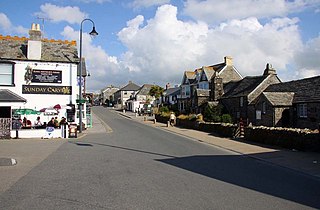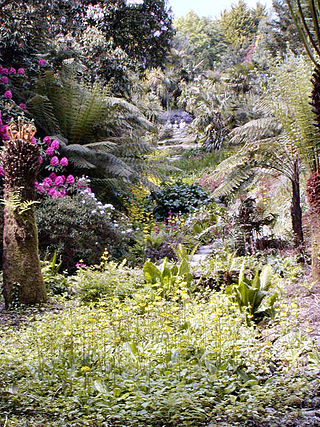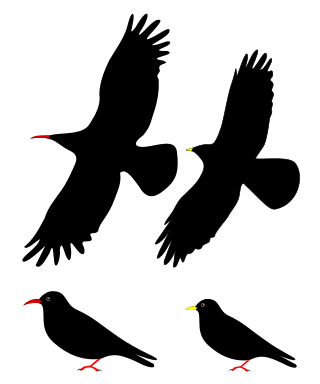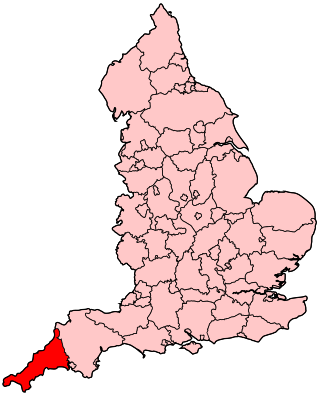Academic career
Thomas' first public lecture was entitled 'The Glebe Lands of Camborne' for the Camborne Old Cornwall Society in 1946, while on a week's leave from the Army in Portsmouth. [8] His academic career officially began as a part-time Workers' Educational Association lecturer in archaeology in Cornwall 1954–58. He became Lecturer in Archaeology at the University of Edinburgh from 1958 to 1967. From 1967 to 1971, he was appointed the first Professor of Archaeology at the University of Leicester. During this period, he became a FSA in 1960 and was awarded a Leverhulme Fellowship [9] for 1965 to 1967. [1]
In 1972 Thomas founded and became director of the Institute of Cornish Studies, affiliated with the University of Exeter at which he was now the first Professor of Cornish Studies. At this time he also launched and edited its learned journal, Cornish Studies . He defined its field as: [10]
"the study of all aspects of man and his handiwork in the regional setting (Cornwall and Scilly), past, present and future. The development of society, industry and the landscape in our fast changing world is as much of concern … as the history of those vast topics in the recent and remote past."
In 1983, he was awarded a Doctorate of Literature by the University of Oxford. He was Sir John Rhys Fellow of the University of Oxford and Visiting Senior Research Fellow at Jesus College from 1985 to 1986. [5]
He retired as Director of the Institute and Professor of Cornish Studies in 1991; he was awarded an Emeritus Fellowship at Exeter by the Leverhulme Trust (1992–94). [5] Thomas was also awarded Doctor of Letters, honoris causa, by the National University of Ireland in 1996. [5]
Archaeological work
Thomas' first archaeological excavation was at the Bronze Age barrow on Godrevy headland, St Ives Bay in 1950, and he initially saw himself as a prehistorian. [11] [12] He was Director of excavations at Gwithian, Cornwall (1949–1963), which revealed an important post-Roman occupation. [13]
He was best known for his contributions to early medieval archaeology, particularly to the archaeology of early Christianity in Britain and Ireland. After Gwithian, excavations at early Christian sites included Nendrum Monastery, County Down in 1954; a chapel at East Porth, Teän, Isles of Scilly in 1956; [14] Iona Abbey, Argyll in 1956–1963; [15] Ardwall Island, Kirkcudbright; [16] and Abercorn, West Lothian 1964–65. [17] His first major work in this field was The Early Christian Archaeology of North Britain (1971), followed by similarly influential volumes including Christianity in Roman Britain to AD 500 (1981) and And Shall These Mute Stones Speak?: post-Roman inscriptions in Western Britain (1994). [5]
Roles in organizations
- Learned societies
He was a board member of the Royal Institution of Cornwall and Honorary Librarian of its Courtney Library until 2011, [18] having previously served as its president in 1970–71. He is a Fellow of the British Academy, and was President of the Council for British Archaeology 1970–73. [19]
He was President of the Cornwall Archaeological Society [20] 1984–88 and of the Society for Medieval Archaeology, 1986–89. [21]
He has been President of the Society for Landscape Studies [22] since 1993. He was president of the Cornish Methodist Historical Association in 1993. He was Chairman of the Society for Church Archaeology, [23] 1995–98.
- Quangos
He has been Chairman of the BBC South West Regional Advisory Council, 1975–80; of the Department of the Environment Area Archaeology Committee, Cornwall and Devon, 1975–79; and of the Cornwall Committee for Rescue Archaeology 1976–88.
He was a Member of the Royal Commission on Historical Monuments (England), 1983–97, its Acting Chairman, 1988–89 and Vice Chairman, 1991–97). [24]

Cornwall is a ceremonial county in South West England. It is recognised by Cornish and Celtic political groups as one of the Celtic nations, and is the homeland of the Cornish people. The county is bordered by the Atlantic Ocean to the north and west, Devon to the east, and the English Channel to the south. The largest urban area in the county is a conurbation that includes the former mining towns of Redruth and Camborne, and the county town is the city of Truro.

Tintagel or Trevena is a civil parish and village situated on the Atlantic coast of Cornwall, England, United Kingdom. The village and nearby Tintagel Castle are associated with the legends surrounding King Arthur and in recent times have become a tourist attraction. It was claimed by Geoffrey of Monmouth that the castle was the place of Arthur's conception.

Camborne is a town in Cornwall, England. The population at the 2011 Census was 20,845. The northern edge of the parish includes a section of the South West Coast Path, Hell's Mouth and Deadman's Cove.

The history of Cornwall goes back to the Paleolithic, but in this period Cornwall only had sporadic visits by groups of humans. Continuous occupation started around 10,000 years ago after the end of the last ice age. When recorded history started in the first century BCE, the spoken language was Common Brittonic, and that would develop into Southwestern Brittonic and then the Cornish language. Cornwall was part of the territory of the tribe of the Dumnonii that included modern-day Devon and parts of Somerset. After a period of Roman rule, Cornwall reverted to rule by independent Romano-British leaders and continued to have a close relationship with Brittany and Wales as well as southern Ireland, which neighboured across the Celtic Sea. After the collapse of Dumnonia, the remaining territory of Cornwall came into conflict with neighbouring Wessex.
Rugby union in Cornwall is Cornwall's most popular spectator sport with a large following. The followers of the national side are dubbed Trelawny's Army. In 1991 and 1999 Cornwall won the County Championship final played at Twickenham Stadium, beating Yorkshire and Gloucestershire respectively to win the Cup. They had another strong spell in the 2010s, reaching seven of the eight finals contested between 2013 and 2022, winning four of them.

The hundreds of Cornwall were administrative divisions or Shires (hundreds) into which Cornwall, the present day administrative county of England, in the United Kingdom, was divided between c. 925 and 1894, when they were replaced with local government districts.
Alfred Kenneth Hamilton Jenkin was a Cornish bard and historian with a particular interest in Cornish mining, publishing The Cornish Miner, now a classic, in 1927.

Camborne and Redruth is a constituency in Cornwall represented in the House of Commons of the UK Parliament since 2024 by Perran Moon of the Labour Party. The seat is on the South West Peninsula of England, bordered by both the Celtic Sea to the northwest and English Channel to the southeast.

Mining in Cornwall and Devon, in the southwest of Britain, is thought to have begun in the early-middle Bronze Age with the exploitation of cassiterite. Tin, and later copper, were the most commonly extracted metals. Some tin mining continued long after the mining of other metals had become unprofitable, but ended in the late 20th century. In 2021, it was announced that a new mine was extracting battery-grade lithium carbonate, more than 20 years after the closure of the last South Crofty tin mine in Cornwall in 1998.

The geology of Cornwall, England, is dominated by its granite backbone, part of the Cornubian batholith, formed during the Variscan orogeny. Around this is an extensive metamorphic aureole formed in the mainly Devonian slates that make up most of the rest of the county. There is an area of sandstone and shale of Carboniferous age in the north east, and the Lizard peninsula is formed of a rare section of uplifted oceanic crust.
The Institute of Cornish Studies is a research institute affiliated with the University of Exeter. Formerly located at Pool, near Redruth, then in Truro, it is now on the University's Penryn Campus near Penryn, Cornwall.
Myrna May Combellack is a Cornish academic researcher and writer of the Institute of Cornish Studies, translator of Beunans Meriasek and author of several works of fiction.
Oliver James Padel is an English medievalist and toponymist specializing in Welsh and Cornish studies. He is currently Honorary Research Fellow in the Department of Anglo-Saxon, Norse, and Celtic, in the University of Cambridge. and visiting professor of Celtic at the University of the West of England

Cornwall is the county that forms the tip of the southwestern peninsula of England; this area has a mild and warm climate regulated by the Gulf Stream. The mild climate allows rich plant cover, such as palm trees in the far south and west of the county and in the Isles of Scilly, due to sub-tropical conditions in the summer.

Frederick Hamilton Davey (1868–1915) was a British amateur botanist who devoted most of his leisure time to the study of the flora of Cornwall, England. Born at Ponsanooth in the Kennall Vale, Cornwall to a large family of limited means, he left school aged 11 to work in the Kennall Powder Mills. Encouraged by his father and local vicar, Davey took to Nature Study as his principal recreation. Of rather a weak constitution, he suffered successive bouts of ill-health, but used his convalescence to further his studies. In 1891, aged 23, he submitted his first paper to the Cornwall Polytechnic Society, followed by several more, earning him various medals in recognition of his industry.

The birds of Cornwall are in general a selection of those found in the whole of the British Isles, though Cornwall's position at the extreme south-west of Great Britain results in many occasional migrants. The nightingale is one English bird which is virtually absent from Cornwall.
Richard James Vincent Larn, OBE is a retired Chief Petty Officer in the Royal Navy, a businessman and maritime history writer who is widely regarded as one of Britain's leading historic shipwreck experts.

The following outline is provided as an overview of and topical guide to Cornwall: Cornwall – ceremonial county and unitary authority area of England within the United Kingdom. Cornwall is a peninsula bordered to the north and west by the Celtic Sea, to the south by the English Channel, and to the east by the county of Devon, over the River Tamar. Cornwall is also a royal duchy of the United Kingdom. It has an estimated population of half a million and it has its own distinctive history and culture.
Presented below is an alphabetical index of articles related to Cornwall:












